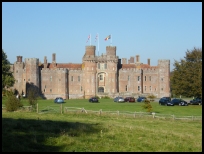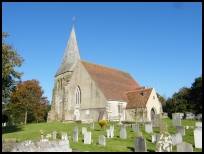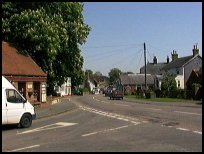|
| |
 Herstmonceux in East Sussex is famous for its castle, which was built by Sir Roger Fiennes
who was a veteran of Agincourt and Treasurer of Henry VI. The castle which
is one of the earliest brick built castles was built by Flemish workmen who
were brought over by Sir Roger in 1441 and built using Flanders bricks. The
castle is about 200ft square with towers, a gatehouse and moat. Herstmonceux in East Sussex is famous for its castle, which was built by Sir Roger Fiennes
who was a veteran of Agincourt and Treasurer of Henry VI. The castle which
is one of the earliest brick built castles was built by Flemish workmen who
were brought over by Sir Roger in 1441 and built using Flanders bricks. The
castle is about 200ft square with towers, a gatehouse and moat.
In 1540 Anne of Cleves visited the castle to be entertained by Lord Thomas
Fiennes, Roger's son who had inherited it from his father. Lord Thomas was
accused of murder in 1541 after an illegal deerhunt on the land of Sir
Nicholas Pelham at nearby Hellingly. The hunting party ended with a fight in
which Lord Pelham's gamekeeper John Busbrig was killed. The hunting party
was found guilty of murder, and Lord Thomas and three others were hung. It
was the first time in English history that a man of noble birth was executed
for the death of a commoner. The reason that Lord Thomas who was 23 at the
time was killed is more than likely to have been due to greedy peers, who
were after the lands owned by the Fiennes.
The castle became a ruin and was demolished in 1777, when much of its
material was used to build Herstmonceux Place.
Herstmonceux castle is said to have a phantom drummer from the Battle of
Agincourt however the more likely explanation is that the drummer was a
smuggler from the 1700's who was trying to scare the local populace away.
This explanation of a smuggling involvement is a similar to the legend of
the Brede giant. The area was a centre of smuggling , due to its proximity
to the coast, and the relatively deserted inland villages.
In the churchyard are a number of Harmer Terracotta plaque decorated
gravestones from the Harmer family of nearby Heathfield dating from the late
1700's to the mid 1800's.
The village has been made famous for its Sussex Trugs, which are a type of
basket made from chestnut and willow. They were brought to public attention
by Thomas Smith of Herstmonceux who displayed his trugs at the Great
Exhibition of 1851. The name trug comes from the Anglo Saxon 'trog' a wooden
boat shaped vessel. These trugs were also built at Hailsham prior to the
Exhibition, but are now only produced at Herstmonceux and nearby Horam .
In 1910 the castle was purchased by Colonel Claude Lowther who partially
restored it. In 1936 Sir Paul Latham completed the restoration of the castle .
In 1946 the Castle became the home of the Royal Greenwich Observatory, from
where they observed the night sky until the early 1970's when the Sir Isaac
Newton 98 inch reflector telescope was moved to the Canary islands. The
Isaac Newton telescope is now found on the top of one of the peaks, where
the air is cleaner and provides significantly better viewing times, as there
are few nights where clouds obscure the view. The Royal Greenwich
observatory was moved to Cambridge in 1988.
Many thanks to Simon Allen
for this correction I note that you describe the Isaac Newton telescope as
36'. It is not.
It was a 98' telescope and when installed was the largest in the
world. It was then moved to La Palma and the mirror was replaced with
another which was 100' in diameter. I suspect you are confusing
reference with the 36' Yapp which is still on the site. |
|
 Herstmonceux in East Sussex church and castle are on the edge of the Pevensey Levels, and
the views from the churchyard towards Eastbourne and the South Downs are
very pretty. Herstmonceux in East Sussex church and castle are on the edge of the Pevensey Levels, and
the views from the churchyard towards Eastbourne and the South Downs are
very pretty.
The village center is just over a mile from the Church and Castle on the main
road from Lewes to Battle , is quite pretty, and you should visit the Sussex Trug
centre. The village was probably relocated after the Black Death in 1348AD as
were a number of other villages in the area.
The church has a mounting block on the wall just outside which was used to help
ladies get on their horses.
The ladies with their long skirts would have had great difficulty on
mounting their horses (even side-saddle) without the aid of these steps. |
|
 The village has a wide range of shops, and services.
The nearest market town is Hailsham a few miles to the South West with many
shops. The nearest main shopping centre is at Eastbourne about 8 miles to
the South. The village has a wide range of shops, and services.
The nearest market town is Hailsham a few miles to the South West with many
shops. The nearest main shopping centre is at Eastbourne about 8 miles to
the South.
The nearest trains depart from Westham , about 7 miles south, to Hastings
or Brighton. |
|
| Herstmonceux is shown as the red symbol on the map. |
|
|
Nearby Villages
(click on symbol to see the village page) |
| Village= | |
Town= | |
Recorded in Domesday= |  |
| |
|
|
Arlington |
(Peaceful Saxon Village) | | 6.44 miles |
|
|
Ashburnham |
(Last Iron Furnace in Sussex) | | 3.36 miles |
|
|
Bodle Street |
(White Horse on the roof) | | 1.93 miles |
|
|
Boreham Street |
(Picturesque village on top of the Ridge) | | 2.14 miles |
|
|
Catsfield |
(Iron, Railways and Clocks) | | 5.67 miles |
|
|
Chiddingly |
(Walking on Cheese ??) | | 5.71 miles |
|
|
Dallington |
(Custers Last Stand!) | | 4.30 miles |
|
|
Hailsham |
(Ropes and Napoleon) | | 3.41 miles |
|
|
Hellingly |
(Only remaining Ciric in Sussex) | | 3.31 miles |
|
|
Hooe |
(The Haunt of Smugglers) | | 3.86 miles |
|
|
Horam |
(Which Station do we get off at ?) | | 4.64 miles |
|
|
Netherfield |
(Village at the top of the Hill) | | 6.08 miles |
|
|
Ninfield |
(Last of the Iron Stocks) | | 4.54 miles |
|
|
Penhurst |
(Beautiful yet Remote) | | 4.46 miles |
|
|
Rushlake Green |
(Open Village and Nuclear Bunker) | | 3.71 miles |
|
|
Vines Cross |
(Cannons and Doodlebugs) | | 4.15 miles |
|
|
Warbleton |
(The Iron Man) | | 3.88 miles |
|
|
Wartling |
(World War II defence centre) | | 2.47 miles |
|
|
Windmill Hill |
(Largest Post Mill in Sussex) | | 0.88 miles |
|
|